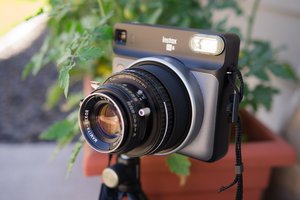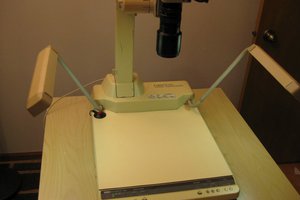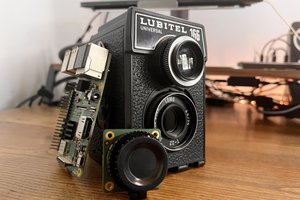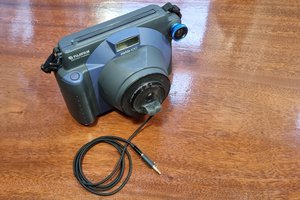Canon 7 Rangefinder Digital Conversion
Converting Canon's 1960's workhorse rangefinder into an APS-C digital camera.
Converting Canon's 1960's workhorse rangefinder into an APS-C digital camera.
To make the experience fit your profile, pick a username and tell us what interests you.
We found and based on your interests.
I have a terrible, terrible habit - and that is speeding through a project without making detailed documentation of the process. Sometimes the momentum just builds and rather than pause to snap a picture or two - and just like that, the camera is already done! I did manage to take a few in-progress photos, though:
Some sample photos from the camera, using the Canon 50mm f/1.8 (the only LTM lens I own):
I'm not entirely sure if it's the nature of the lens, but it certainly is not very sharp! It improves a little bit when stopped down, but off-center softness is very evident when focusing on distant subjects. I suspect that the sensor is skewed a bit and doesn't align perfectly with the image plane. The sensor is held in place rather lackadaisically without any real measures to ensure alignment other than relying on the dimensional accuracy of the 3D print. One of these days I'll need to place a depth gauge between the sensor and the lens flange, and try to get it dialed in. But for now, I'm just glad that it works!
Ah, finally - some progress to report. All of the parts and pieces are in at last. The pieces I was anticipating the most were definitely the 3D printed pieces. All were printed in Shapeways' MJF plastic, which I have had numerous excellent experiences with. I used their medium-fast service and I had parts on my doorstep within 2 weeks. I also ordered one translucent SLA part (a replacement frameline window for the Canon 7 - mine crumbled into dust during disassembly), which took a couple more days to print and be processed. If I had printed everything in MJF, I'm sure it would have been even faster.
I've already started the process of putting the camera together, but there have been two major setbacks:
There was some success, however, with doing some of the electrical setup for the conversion. First, a bespoke solution is needed to connect the battery to the motherboard. To fit inside the Canon 7, the battery compartment of the NEX has to be rotated 90 degrees and sit just behind the motherboard, as shown below. The original flex connector is not meant to contort in such ways, so I snipped off the end and soldered 3 strands of a flat ribbon cable between it and the battery contacts. It's a tedious and careful job to strip away enough of the polyamide insulation on the flex circuit to expose enough bare area to solder to.
The top flex circuit of the NEX has some very important features: it holds the power switch, shutter button, and a button to enter playback mode. These will all be "broken out" via flying wires to locations easily accessible under the Canon 7's top shell (the exploded diagrams in the last entry may help to explain this). More tedium, but after a bunch of squinting and careful tweezer action, 38 AWG leads have been attached to the proper points on the flex circuit:
Here's the idea. Let's make a digital rangefinder camera by combining the electronic bits of a Sony NEX-5 (the OG version circa 2010-2011) and the body and rangefinder unit pulled from a Canon 7.
I should point off off the bat that this isn't something new - there have been various successful efforts to combine film cameras and digital sensors (see: https://frankencamera.wordpress.com/2014/08/30/the-making-of-frankencamera/). My tenuous claim to originality is that nobody (to my knowledge) has done this to an Leica Thread Mount (LTM) rangefinder, let alone the Canon 7.
Perhaps the best way to introduce this project would be to answer the "whys":
Based on others' work, I was feeling pretty confident that shoehorning this would work out. But still, I did a bit of research before buying parts. Repair manuals for both the Canon 7 and NEX-5 are available online (and free, with a little Googling) and are great resources for figuring out how things fit together. The NEX-5 also has vector drawings of the camera in various states of disassembly, which appear to be true to scale - which I used to make some mockups. Both the NEX and 7 are very prolific cameras, so there is an abundance of repair walkthroughs and teardowns showing off their guts - all good fuel for the imagination when considering how things will fit together.
I happened upon a 7 and an NEX-5 on eBay for $65 and $80, respectively. Both were in pretty well-used condition, and the 7 had recently undergone some surgery to fix a dislodged beamsplitter for the framelines... which immediately undid itself during transit. So, I had the opportunity to get familiar with the optical layout of the 7. Nothing a well-placed dab or two of super glue couldn't fix.
Create an account to leave a comment. Already have an account? Log In.
Become a member to follow this project and never miss any updates

 Kevin Kadooka
Kevin Kadooka
 Quinn
Quinn
 Gradivis
Gradivis